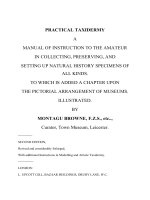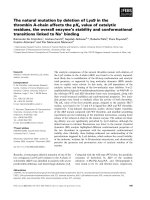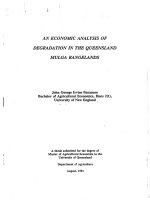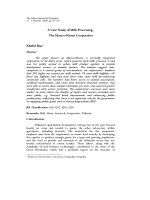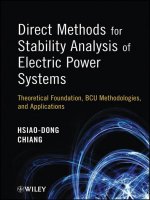A multimodal discourse analysis of christopher nolans the dark knight a cooperative and cinematic discourse perspective
Bạn đang xem bản rút gọn của tài liệu. Xem và tải ngay bản đầy đủ của tài liệu tại đây (2.65 MB, 225 trang )
A MULTIMODAL DISCOURSE ANALYSIS OF CHRISTOPHER
NOLAN’S THE DARK KNIGHT:
A COOPERATIVE AND CINEMATIC DISCOURSE PERSPECTIVE
TOH WEIMIN
(BA (Hons), NUS)
A THESIS SUBMITTED
FOR THE DEGREE OF MASTER OF ARTS
DEPARTMENT OF ENGLISH LANGUAGE AND LITERATURE
NATIONAL UNIVERSITY OF SINGAPORE
2010
ACKNOWLEDGEMENTS
First, I wish to express my heart-felt gratitude to my supervisor, Associate Professor
Ismail S Talib, who supported me for the research scholarship and for spending much time
going through my thesis and suggesting helpful advice, feedback and sharing personal
anecdotes about doing research.
Second, I would like to thank Chee Kien for spending much of his time communicating
with me via emails to criticise and suggest rewrites to the drafts of my thesis. I appreciate the
harsh criticisms and feedbacks that were given to me which greatly helped to improve the
thesis over the past few months in the course of writing.
I would also like to thank Associate Professor Kay O‟Halloran for allowing me access to a
softcopy of Chiaoi Tseng‟s PhD dissertation on the construction of filmic thematic
configuration which was used in the analysis of the narrative themes in my thesis. Many
thanks also to Dr Peter Tan and the other professors at the English Language and Literature
Department who have rendered any help to me during the period of my research candidature.
Last but not least, I would like to thank my family members who provided me with
constant encouragement and support.
ii
TABLE OF CONTENTS
Page
1
ACKNOWLEDGEMENTS
ii
TABLE OF CONTENTS
iii
ABSTRACT
xi
LIST OF TABLES
xiii
LIST OF FIGURES
xvi
ABBREVIATIONS
xix
INTRODUCTION
1
1.1
Overview and Research Focus
1
1.2
Short Synopsis of The Dark Knight
2
1.3
Main Characters‟ Introduction
3
1.3.1 Batman/Bruce Wayne
3
1.3.2 Harvey Dent/Two Face
3
1.3.3 Lieutenant/Police Commissioner James Gordon
3
1.3.4 The Joker
4
1.4
Aims of the Study
4
1.5
Research Questions
5
1.6
Definition of Multimodality
6
1.7
Definition of Intersemiosis
7
1.8
Background of Christopher Nolan‟s The Dark Knight (2008)
8
1.8.1
8
Overview and Critical Reception of The Dark Knight
iii
1.8.2
Plot and Narrative Themes/Idea of The Dark Knight
9
1.8.2.1
The Idea of Escalation and Theme of Moral
Ambiguity
9
1.8.2.2
Good versus Evil
10
1.8.2.2.1 The Triumph of Evil over Good
10
1.8.2.2.2 The Defeat of Evil
10
1.8.2.3 The Symbology of Batman
1.8.3
1.9
1.10
10
1.6.2.3.1 The heroic vigilante
11
1.6.2.3.2 The incorruptible hero
11
1.6.2.3.3 The Dark Knight
11
Narrative Themes/Ideas and Their Relation to the
Analysis
Rationale for Selection of Christopher Nolan‟s The Dark
Knight (2008)
Literature Review
12
12
15
1.10.1
H.P Grice‟s (1975) Cooperative Principle
15
1.10.2
H.P Grice‟s (1975) Cooperative Principle To
Analyse Television/Cinematic Texts
17
1.10.2.1 Integrated Linguistic Frameworks To
Analyse Linguistic Dialogue of a Television
Text
17
1.10.2.2 Grice‟s (1975) CP To Analyse
Linguistic Dialogue of Television/
Cinematic Texts
17
1.10.2.3 Integrated Frameworks To Analyse
Dialogue and Visuals In a
Cinematic text
18
1.10.2.4 Grice‟s (1975) CP Applied To Visual Analysis
of Several Cinematic Texts
19
iv
2
1.10.3 Halliday‟s (1994) SFL used to analyse visual and
cinematic texts
19
1.10.4 Past Research conducted on Batman films and related
franchises
20
1.11 Outline of Thesis
21
METHODOLOGY
23
2.1
Overview
23
2.2
Rationale for a Cooperative Approach
23
2.3
Attardo‟s Supplement of the CP with Cognitive Contextual
24
Categories
2.4
Austin‟s (1962) Speech Act Theory
25
2.5
Kress and van Leeuwen‟s (1996) framework of visual analysis
25
2.5.1 Camera Techniques
26
2.5.2 Ideational metafunction
28
2.5.2.1 Narrative Structures
28
2.5.2.2 Conceptual Structures
31
2.5.3 Interpersonal Metafunction
32
2.5.4 Textual metafunction
34
2.6
The Intersemiotic Meaning Potential
35
2.7
Tseng‟s (2009) Filmic Thematic Configuration
35
2.8
The Integrative Multisemotic Model (Lim, 2004) for Film
Analysis
38
2.8.1 The content plane
39
2.8.2 The context plane
42
v
3
SELECTION AND TRANSCRIPTION OF DATA
44
3.1
Overview
44
3.2
Criteria for Selection of Scenes
44
3.2.1 Description and Rationale of Scenes Selected for
Analysis
45
Transcription layout of the scenes chosen for analysis
46
3.3.1 Rationale for the segmentation of the cinematic text on
a shot-by-shot basis
46
3.3.2 Transcription layout and notational conventions
47
3.3
4
3.3.2.1 Image Track
47
3.3.2.2 Linguistic Dialogue Track
50
(NON) COOPERATION AND COMPETITION IN THE DARK
KNIGHT
52
4.1 Overview
52
Data Set 1
4.2 Analysis of Scene One – Gordon‟s First Meeting With Dent
52
4.2.1 Gordon and Dent‟s Initial Cooperation Indicated
Through Exchange Greetings
53
4.2.2 Use of Two Shot to Emphasise Closeness between
Gordon and Dent
54
4.2.3 Gordon‟s Flouting of Maxims of Quantity/
Manner Implicate “Non-Cooperation”
55
4.2.4 Dent‟s Flouting Maxim of Relation Implicate
Annoyance
60
vi
4.2.5 Displacement of Two Shot by Shot-Reverse-Shot
Emphasise “Non-Cooperation”
62
4.2.6 Further Flouting of Maxims of Relation, Manner and
Quantity by Gordon
64
4.2.7 Gordon‟s Flouting of Maxims of Quality, Quantity
and Manner
66
4.2.8 Conclusion of Analysis – Competition
and Cooperation between Dent and Gordon
68
Data Set 2
4.3 Analysis of Scene Two – Batman‟s interrogation of the Joker
4.3.1 “Non-Cooperation” of the Joker
4.3.1.1 Batman‟s strategy of intimidation by violence
– the big bad vigilante
4.3.1.2 Joker‟s strategy of information/disinformation
one - Guilt
4.3.2 Batman‟s Cooperation With the Joker
69
69
69
72
73
4.3.2.1 Joker‟s strategy of information/disinformation
two – Bring Batman down to his level
73
4.3.2.2 Joker‟s strategy of information/disinformation
three – Playing with rules
75
4.3.2.3 Joker‟s strategy of information/disinformation
four – Rachel as a trump card
77
4.3.2.4 Joker‟s strategy of information/disinformation
five – Chance and choices
80
vii
4.3.3 Conclusion
84
4.3.3.1 Inversion of Interrogator and Suspect Role –
Breaking of Schema in interrogation of suspects
85
4.3.3.2 Moral ambiguity and ambivalence of Batman
86
4.3.3.3
87
Competition and cooperation between the
Joker and Batman
Data Set 3
87
4.4 Analysis of Scene Three - Dent‟s Hospitalisation at Gotham
General Hospital and Interaction With Gordon
87
4.4.1 The “Non-Cooperation” of Dent with Gordon
88
4.4.2 Dent‟s Intense Negative Emotions and Deteriorating
Relationship with Gordon
92
4.4.3 Conclusion of Analysis – Competition
between Gordon and Dent
96
Data Set 4
4.5 Analysis of Scene Four - Dent‟s Hospitalisation at Gotham
General Hospital and Corruption
97
4.5.1 Opening a Communication Channel for Corrupting Dent
99
4.5.2 Disorientating Dent for Corruption
101
4.5.3 The Joker‟s Strategy To Turn Dent Against Himself
107
viii
4.5.4
5
The Joker‟s Strategy to Guide Dent to Become “TwoFace”
4.5.5 Dent‟s Corruption and Adoption of the Joker‟s Methods
111
4.5.6 Conclusion of Analysis – Cooperation
and Competition between Dent and the Joker
113
UNCOVERING THE NARRATIVE THEMES OF THE DARK
KNIGHT AND IMPLICATIONS OF ANALYSIS
117
5.1 Aim of Chapter
117
5.2 Discussion In Relation to Narrative Themes
119
5.2.1 Escalation, Moral Ambiguity and The Triumph of Evil
Over Good
119
5.2.1.1 Escalation
125
5.2.1.2 Moral Ambiguity
126
5.2.1.3 Triumph of Evil over Good
126
5.2.2 Symbology of Batman, Moral Ambiguity, Good Versus
Evil and the Defeat of Evil
5.3 Implications of Analysis
5.3.1 Holistic Nature of Cinematic Text Uncovered Through
an Integrative Model
6
108
127
131
131
CONCLUSION
135
6.1
135
Summary of Main Findings
ix
6.2
Limitations of this study
136
REFERENCES
139
APPENDIX 1 : Film Script For Scenes 1-4
145
APPENDIX 2 : Thematic Configuration Diagrams
154
APPENDIX 3 : Selected Transcription and Analysis Tables
194
x
ABSTRACT
A movie is multimodal in nature. As such, a holistic approach with equal emphasis on
both linguistic and non-linguistic aspects of film is essential to the discourse analysis of a
cinematic text. This study proposes an integrated framework for the analysis of the
multimodal semiotic resources of cinematic texts. This proposed framework integrates the
key components of linguistic pragmatic frameworks and visual frameworks to enable a
comprehensive analysis of multi-semiotic resources in a movie.
The linguistic pragmatic framework includes interactional discourse frameworks such
as Grice‟s (1975) Cooperative Principle and its attendant maxims, and Austin‟s (1962)
Speech Act Theory. Attardo‟s cognitive contextual categories of goal, (a)symmetry and
(c)overtness of information possessed by the interlocutors in a dialogue are used to provide a
high macro view to understand why certain motives, strategies and tactics are used by
interlocutors. The visual framework includes the incorporation of the camera framework into
Kress and van Leeuwen‟s (1996, 2006) Grammar of Visual Design to cater to the analysis of
dynamic moving images in cinematic texts. Royce‟s (1998b; 2007) and Tan‟s (2005)
conceptions of intersemiotic meaning potential are used to demonstrate how the linguistic and
visual modalities interact with each other to produce the overall meanings. Tseng‟s (2009)
filmic thematic configuration is used for the understanding of how character actions and
interactions in the scene are correlated with the narrative themes of the cinematic text.
In this study, Christopher Nolan‟s The Dark Knight (2009) is posited as the cinematic
text to demonstrate how the integrated framework can be applied for the analysis. To explain
how the integrated framework works, two overarching objectives are created. First, a
narrative approach is utilised as a point of reference to analyse the cinematic text. The
analysis of the narratology of the cinematic text includes the characters, their relationships
xi
and the narrative themes. The second overarching objective demonstrates the internal
workings of a cinematic text.
This study shows that although independent analyses of linguistic and visual semiotic
resources can produce meanings on their own, their meanings are incomplete when viewed in
the context of the movie. The linguistic and visual semiotic resources coordinate and
negotiate with each other throughout a movie to produce a convergent and/or divergent
meaning. This study argues that a holistic approach using an integrated framework that
considers both semiotic resources needs to be applied in the discourse analysis of a cinematic
text to uncover the new/multiple meanings that are created. Through the demonstration of the
workings of semiotics in a cinematic text, the thesis is an attempt to contribute to film
appreciation by raising awareness on how the movie works internally in a holistic manner and
serves to enhance our experience and enjoyment of cinema. It may also help us better
understand the movies we watch and how they are related to society and culture in general.
xii
LIST OF TABLES
Table
Title
Page
1.1
H.P. Grice‟s (1975) Four Maxims and Sub-Maxims
16
2.1
Attardo‟s (1997) Cognitive Contextual Categories
24
2.2
Austin‟s (1962) Speect Act Theory
25
2.3
Types of Camera Techniques
27
2.4
Kress and van Leeuwen‟s (1996) Process Types in Narrative
Structures
29
2.5
Kress and van Leeuwen‟s (1996) Circumstances in Narrative
Structures
30
2.6
Kress and van Leeuwen‟s (1996) Process Types in Conceptual
Structures
32
2.7
The Textual Metafunction and the use of Camera Techniques
Incorporated
34
2.8
Partial Reproduction of Tan‟s (2005) Analytical Framework for
Analysing Intersemiotic Meaning Potential in Television
Advertisements
35
2.9
The Integrative Multisemiotic Model (Lim, 2004) Proposed for
Film Analysis
38
3.1
Excerpt of Transcription Template for a Visual Analysis of The
Dark Knight.
49
3.2
Excerpt of Transcription Template for a Linguistic Analysis of
The Dark Knight.
51
4.1
Dent‟s strategy one - verbal irony
53
xiii
Table
Title
Page
4.2
Dent‟s strategy two - trivializing Gordon‟s effort
55
4.3
Dent‟s strategy three - cutting Gordon off to put him in his place
55
4.4
Dent‟s strategy four – resume his aggressive strategy by
attacking the integrity of M.C.U.
60
4.5
Dent‟s strategy five - backing down, acceding to Gordon‟s
request for warrant and makes a final plea for Gordon‟s trust
64
4.6
Dent‟s final strategy - take advantage of Gordon‟s effort to mend
their relationship by baiting him
66
4.7
Batman‟s strategy of intimidation by violence – the big bad
vigilante
69
4.8
Joker‟s strategy of information/disinformation one - Guilt
72
4.9
Joker‟s strategy of information/disinformation two – Bring
Batman down to his level
73
4.10
Joker‟s strategy of information/disinformation three – Playing
with rules
75
4.11
Joker‟s strategy of information/disinformation four – Using
Rachel as a trump card
77
4.12
Joker‟s strategy of information/disinformation five – Chance and
choices
80
4.13
Gordon‟s remorse
88
4.14
Dent‟s exposition of Two-Face
90
4.15
Joker‟s strategy of corruption one – proclaiming innocence?
99
4.16
Joker‟s strategy of corruption two – what I am, what I am not
and what I am doing
101
4.17
Social Distance as conveyed by the Cinematic Frame
104
4.18
Joker‟s strategy of corruption three – what I did, what they did,
what they are and what you are - expendable
107
xiv
Table
Title
Page
4.19
Joker‟s strategy of corruption four – what you need to do, Be
like me
108
4.20
Dent‟s transformation – chances not choice
111
4.21
Summary of Integrated Multi-modal Analysis of Scenes – Part 1
115
4.22
Summary of Integrated Multi-modal Analysis of Scenes – Part 2
116
5.1
Semantic Relations of Dent for Scene One
119
5.2
Semantic Relations of Gordon for Scene One
119
5.3
Semantic Relations of Dent for Scene Three
120
5.4
Semantic Relations of Dent for Scene Four
120
5.5
Semantic Relations of Batman for Scene Two
127
5.6
Semantic Relations of the Joker for Scene Two
128
xv
LIST OF FIGURES
Figure
Title
Page
2.1
Narrative Structures in Visual Images (Kress and van Leeuwen,
1996: 73)
31
2.2
Systems of choices for interactive relations and their realisation
(Kress and van Leeuwen, 1996: 154)
33
2.3
Reproduced from Tseng (2009) The development of RT‟s
semantic relations across the three confrontation with VD
37
2.4
A medium close-up shot of Gordon
41
2.5
An oblique angle showing Dent‟s face
42
4.2.1
A two shot portrays Gordon and Dent as allies
54
4.2.2
Intersemiotic Antonym between utterance in DS1:7a and Visual
Shot
59
4.2.3
A medium close-up shot emphasises Gordon‟s control, providing
stark contrast to the aggressive verbal dialogue in DS1:11a-11c
62
4.2.4
Shot-Reverse-Shot showing the “non-cooperation” of Gordon to
Dent‟s persistent requests/demands to join Gordon and Batman‟s
crime fighting alliance
64
4.2.5
Medium close-up shot of Gordon emphasizes his final decision
not to include Dent in his plan to clean up Gotham City
66
4.2.6
A medium close-up shot of Gordon turning his head in an
oblique angle away from Dent indicates his visual opting out of
the dialogue
68
4.3.1
A close-up shot of the Joker foreshadows Batman‟s use of
violence on him throughout the scene
70
4.3.2
An extreme close-up shot of Batman‟s punch on the Joker‟s
fingers
71
4.3.3
A two-shot emphasises increasing tension between Batman and
the Joker
76
4.3.4
A long shot of Batman jamming the door with a chair suggests
his intention to break his moral code of not killing
79
xvi
4.3.5
A medium close-up shot emphasises Batman‟s persistent use of
transactional action processes
79
4.3.6
A medium close-up shot conveys Batman‟s use of a
transactional action process on the Joker
81
4.3.7
Intersemiotic Attitudinal Dissonance and Intersemiotic Antonym
between the close-up shot that emphasises the Joker‟s
confidence and the linguistic utterance “revealing” Dent and
Rachel‟s hidden locations
82
4.3.8
A low angle shot places Batman in a position of Superiority
which is recontextualised by the Joker‟s utterances (DS2:28a28b), to create Intersemiotic Attitudinal Dissonance and
Intersemiotic Antonym
83
4.3.9
A high angle shot places the Joker in a position of Inferiority
which is recontextualised by the Joker‟s utterances (DS2:28a28b) to create Intersemiotic Attitudinal Dissonance and
Intersemiotic Antonym
84
4.4.1
An oblique angle of Gordon turning his face away from the
camera foregrounds his fulfilment of the maxim of quality
89
4.4.2
An oblique angle of Dent with a lack of bidirectional reactional
process foregrounds Dent‟s rapidly deteriorating relationship
with Gordon
89
4.4.3
A close-up shot of Dent as he slowly turns his face towards the
camera/Gordon
92
4.4.4
A medium close-up shot of Gordon
93
4.4.5
Two close-up shots emphasise Dent‟s deteriorated relationship
with Gordon and his opting out of the dialogue
94
4.4.6
A close-up shot of Dent showing the scarred side of his face in a
frontal angle
96
4.5.1
A medium shot of Dent foregrounds his antagonistic relationship
with the Joker
100
4.5.2
A medium shot of Dent indicating his darting gazes suggests his
desire to get out of his restraints
100
4.5.3
A close-up shot of Dent showing his head in a left moving
vector foregrounds his antagonistic relation with the Joker
103
4.5.4
Intrasemiotic antonym between the analytical process of the
Joker‟s hands clasping Dent‟s right hand in the foreground and
106
xvii
the analytical process of Dent‟s legs jerking in the background
4.5.5
A two-shot foregrounds Dent‟s intense hatred of the Joker
106
4.5.6
A medium close-up shot provides another perspective of Dent‟s
intense hatred of the Joker
106
4.5.7
A medium close-up shot of the Joker corrupting Dent
109
4.5.8
A medium close-up shot of the Joker guiding Dent to point the
gun at his forehead
109
4.5.9
A close-up shot of Dent shows his gaze forming a bidirectional
reactional transactional process with the Joker
110
4.5.10
A close-up shot foregrounds Dent‟s intense hatred for the Joker
112
xviii
ABBREVIATIONS
CP
Cooperative Principle
DA
District Attorney
IMM
Integrative Multisemiotic Model
MCU
Major Crimes Unit
POV
Point-of-view
RT
Roger Thornhill
SFL
Systemic Functional Linguistics
VD
Vandamm
xix
CHAPTER ONE
INTRODUCTION
1.1 Overview and Research Focus
The thesis proposes an integrated framework to analyse cinematic text as a whole by
focusing on the holistic analysis of the cinematic text from two perspectives. The first
perspective involves the use of an interactional discourse analysis approach to analyse the
dialogue of the selected movie scenes, focusing on the characterisation, character interactions
and relationships. The second perspective involves the use of a visual analysis approach that
incorporates the use of camera techniques into Kress and van Leeuwen‟s visual framework
(1996, 2006) to analyse how the scene is staged for the audience.
In this integrated framework, the interactional discourse analysis of the verbal
dialogue is integrated with the visual analysis which constitutes the holistic analysis of the
cinematic text (Talib, 2009a, 2009b). Kress and van Leeuwen‟s (1996) visual analysis,
Austin‟s (1962) illocution and perlocution are used to form a triangulation of evidence where
the visual and linguistic evidence support each other. Grice‟s (1975) Cooperative Principle
and its attendant maxims are used as a macro entry to the analysis. Attardo‟s (1997) cognitive
contextual categories are used to create a high level macro view of the evidence. Relating the
holistic analysis of the selected movie scenes with the themes of the cinematic text will
capture a fuller picture of the character interactions, characterisation and relationships in
relation to the themes analysed.
The rationale for a holistic analysis of a cinematic text is that most texts are
multimodal constructs, involving the use of more than one meaning-making resource for the
creation of meaning. Modalities in film involve the use of dynamic co-occurring moving
images, written and verbal linguistic text and music. These can be diegetic (occurring in the
story world of the narrative) or non-diegetic (occurring outside the story world of the
1
narrative). Hence, I utilise the pragmatic interactional discourse analysis frameworks, which
are complemented by Kress and van Leeuwen‟s (1996) Grammar of Visual Design, in order
to systematically analyse how the co-occurring modalities (linguistic and moving visual
images) within a film interact with each other in the process of meaning creation. Adolphs
and Carter (2007:133) noted that social interactions represented as conversational interactions
in the film text are in fact multimodal, combining both verbal and nonverbal elements.
In my study, I assign equal importance to the roles of linguistic and visual modalities
in creating the overall meaning in the film text. Traditional approaches to discourse analysis
tend to emphasise the role of linguistic modality. However, visual modalities in film texts are
equally important as nonverbal components of expression not only combine with words to
make meaning, but also replace words and stand as meaning making devices in their own
right (Harris and Luque, 2009).
The methodology of this integrated framework and its components will be discussed
in detail in Chapter Two. A short synopsis of The Dark Knight and main characters‟
introduction are provided in Sections 1.2 and 1.3. Sections 1.4 and 1.5 state the aims of this
thesis and the research questions. Sections 1.6 and 1.7 elaborate on the terms multimodality
and intersemiosis. Section 1.8 provides background information on The Dark Knight, the
movie I selected for analysis. Section 1.9 provides the rationale for my choice of The Dark
Knight. Section 1.10 discusses the review of literature relevant to my study and Section 1.11
concludes the chapter with an outline of the thesis chapters.
1.2 Short Synopsis of The Dark Knight
In The Dark Knight, Batman, Lieutenant James Gordon and District Attorney Harvey
Dent set out to dismantle the remaining criminal organisations that plague Gotham streets.
However, their actions contribute to the rise of the antagonist known as the Joker. The Joker
2
thrusts Gotham City into chaos and forces the protagonists Batman, Gordon and Harvey Dent
to cross the fine line between Good and Evil.
1.3 Main Characters’ Introduction
1.3.1 Batman/Bruce Wayne
Batman is the primary protagonist of The Dark Knight. His second identity is
billionaire Bruce Wayne who acts as a facade to hide his superhero identity as Batman. The
characterisation of Batman undergoes a dynamic evolution from heroic vigilante to
incorruptible hero and eventually to the Dark Knight by the end of the film. Batman enforces
the law through unorthodox means and thus serves as an appropriate means to bring back
criminals that have escaped from the jurisdictions of Gotham law enforcers.
1.3.2 Harvey Dent/Two Face
Harvey Dent is the elected District Attorney of Gotham City. He symbolises the
legitimate arm of law who brings criminals to justice by orthodox lawful means. Dent
complements Batman in dismantling criminal organisations in Gotham City. Without Dent,
criminals which have been brought back by Batman through unorthodox means cannot be
brought to justice through the courts of law. Dent‟s character undergoes an evolution to turn
antagonist after Rachel who is Dent‟s girlfriend is killed by the Joker in a warehouse
explosion that also disfigured Dent‟s face.
1.3.3 Lieutenant/Police Commissioner James Gordon
Gordon is the leader of Gotham City Police Department‟s Major Crime Unit. He has
been working with Batman and Harvey Dent to apprehend the new leaders of the criminal
organisations in Gotham City. James Gordon is promoted to Police Commissioner in the film
3
after Commissioner Loeb is killed when he drinks the whiskey with the Joker‟s acid. Gordon
symbolises the pragmatic nature of law fighting who adopts expedient measures to combat
criminal elements in Gotham City.
1.3.4 The Joker
The Joker is the antagonist to Batman in The Dark Knight. The Joker acts as the
catalyst to contribute to the dynamic evolution of Batman and Harvey Dent in The Dark
Knight. The Joker symbolises chaos and his goal is to create a world without rules.
1.4 Aims of the Study
This study focuses on the discourse analysis of Christopher Nolan‟s The Dark Knight
(2008). It has two overarching objectives which are in turn subdivided into their respective
sub-objectives.
i.
To analyse the narrative structure of the text in terms of the following subobjectives.
a. To analyse the way(s) that the characterisation of Harvey Dent develop(s) as
the movie progresses. Dent appears in three out of the four scenes analysed
and a focused analysis on Dent can foreground the themes of the triumph of
evil over good, moral ambiguity and the idea of escalation.
b. To trace the developing relationship between the protagonists, Harvey Dent,
and Gordon.
c. To link the micro analysis to the macro analysis of the narrative theme of the
film, and relate these analyses to our society at large.
4
ii.
To propose a systematic framework for the multimodal discourse analysis of film
texts. My aim is an integrated framework for the discourse analysis of the visual
and linguistic modalities in terms of the following sub-objectives.
a. To uncover the different meanings conveyed through the linguistic and visual
modalities of the cinematic text.
b. To study how the different linguistic and visual modalities of the film interact
to produce a multiplicative meaning in the cinematic text.
c. To study how the process of intersemiosis, in line with Ravelli‟s (2000) and
Royce‟s (1998b, 2007) definition, works in film. Their definition of
intersemiosis is outlined in section 1.5 below.
This study aims to demonstrate that by using an integrated approach that combines
frameworks used in linguistic analysis with those used in visual analysis, a better insight into
the portrayal of characters in The Dark Knight can be achieved. Ultimately, this thesis also
hopes to increase the awareness of how the linguistic and the visual semiotic modalities,
coordinate and contribute to meaning making potentialities.
1.5 Research Questions
The research questions formulated to support the aims of the study are as follows:
i.
Narrative Structure of the text
a. How are the protagonists Batman/Bruce Wayne and Harvey Dent
characterised?
b. How does the relationship between Harvey Dent and Gordon develop as the
film progresses?
5
c. How does the micro analysis using the integrated multi-modal analysis
framework relate to the macro themes of the text?
d. How does the macro analysis relate to our society?
ii.
Systematic framework for multimodal discourse analysis of the cinematic text
a. What are the different meanings conveyed through the visual and linguistic
modalities of a cinematic text?
b. Do the different linguistic and visual modalities interact to produce a divergent
and/or convergent meaning in the text?
i. Are the final meanings produced multiplicative?
c. How do the different modalities in the cinematic text interact and coordinate to
produce the final meanings in the cinematic text?
d. How are the linguistic pragmatic and visual analyses related to the narrative
themes?
1.6 Definition of Multimodality
The notion of multimodality emphasises that a multiplicity of semiotic resources is
used for the meaning-making processes (Baldry 2000; Iedema 2003a & 2003b; Kress and van
Leeuwen 1996; Kress et al 2001; Thibault 2000). Most forms of communicative texts are
multimodal rather than monomodal. Multimodality stresses that there is coordination and
integration of meanings realised by the different co-present semiotic resources, so that the
final meaning is created from their co-integration. From the communicative perspective, copatternings and co-ordinations of semiotic modalities and meanings are organised with
reference to communicative contexts, and these social contexts therefore play a crucial role in
shaping the semiotic resources that are used. Ultimately, the meaning of the final product
6


